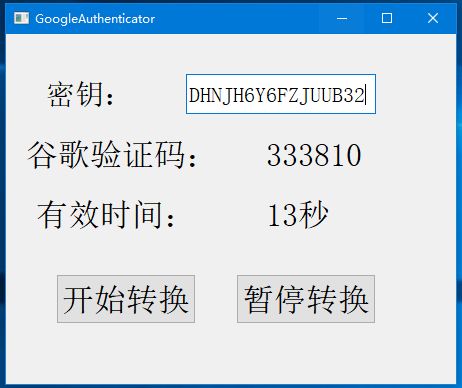致谢声明
1.本文学习nanhuier的博客《Python计算谷歌身份验证器的验证码》并优化其中代码。
原博客链接:https://blog.csdn.net/nanhuier/article/details/77679200
2.本文学习莫水千流的博客《程序员之路:python3+PyQt5+pycharm桌面GUI开发》,
成功搭建PyQt5+Pycharm的开发环境,建议读者先按照此文配置好环境。
原博客链接:https://www.cnblogs.com/zhoug2020/p/9039993.html
3.本文学习maicss的github工程《PyQt5-Chinese-tutorial》
github链接:https://github.com/maicss/PyQt5-Chinese-tutorial
4.本文学习晴空行的博客《Python打包方法》,
原博客链接:https://www.cnblogs.com/gopythoner/p/6337543.html
0.完整代码
读者安装PyQt5库后可以直接运行此段代码查看程序效果。
安装PyQt5库命令:pip install pyqt5
本文的第1节《定义函数getGoogleCode》、第2节《定义类Ui_Form》、第3节《定义程序入口,即主函数main》是本节《完整代码》的分段讲解。
import base64, time, struct, hmac, hashlib
def getGoogleCode(secretKey):
decoded_secretKey = base64.b32decode(secretKey, True)
interval_number = int(time.time() // 30)
message = struct.pack(">Q", interval_number)
digest = hmac.new(decoded_secretKey, message, hashlib.sha1).digest()
index = ord(chr(digest[19])) % 16
googleCode = (struct.unpack(">I", digest[index:index+4])[0] & 0x7fffffff) % 1000000
return "%06d" %googleCode
from PyQt5.QtGui import QFont
from PyQt5.QtWidgets import QApplication, QMainWindow, QLabel, QLineEdit, QPushButton
from PyQt5.QtCore import QCoreApplication, QTimer, QRect, QMetaObject
class Ui_Form(object):
def setupUi(self, Form):
#Form setting
Form.setObjectName("googleAuthenticator")
Form.resize(450, 350)
#lineEdit_secretKey setting
self.lineEdit_secretKey = QLineEdit(Form)
self.lineEdit_secretKey.setGeometry(QRect(180, 40, 190, 40))
font = QFont()
font.setFamily("Agency FB")
font.setPointSize(16)
self.lineEdit_secretKey.setFont(font)
self.lineEdit_secretKey.setObjectName("lineEdit_secretKey")
#label setting
self.label = QLabel(Form)
self.label.setGeometry(QRect(40, 40, 70, 40))
font = QFont()
font.setFamily("Agency FB")
font.setPointSize(22)
self.label.setFont(font)
self.label.setObjectName("label")
#label_2 setting
self.label_2 = QLabel(Form)
self.label_2.setGeometry(QRect(20, 100, 170, 40))
font = QFont()
font.setFamily("Agency FB")
font.setPointSize(24)
self.label_2.setFont(font)
self.label_2.setObjectName("label_2")
#label_googleCode setting
self.label_googleCode = QLabel(Form)
self.label_googleCode.setGeometry(QRect(260, 100, 140, 40))
font = QFont()
font.setFamily("Agency FB")
font.setPointSize(24)
self.label_googleCode.setFont(font)
self.label_googleCode.setText("")
self.label_googleCode.setObjectName("label_googleCode")
#lable_3 setting
self.label_3 = QLabel(Form)
self.label_3.setGeometry(QRect(30, 160, 140, 40))
font = QFont()
font.setFamily("Agency FB")
font.setPointSize(24)
self.label_3.setFont(font)
self.label_3.setObjectName("label_3")
#label_validTime setting
self.label_validTime = QLabel(Form)
self.label_validTime.setGeometry(QRect(260, 160, 140, 40))
font = QFont()
font.setFamily("Agency FB")
font.setPointSize(24)
self.label_validTime.setFont(font)
self.label_validTime.setText("")
self.label_validTime.setObjectName("label_validTime")
#pushButton setting
self.pushButton = QPushButton(Form)
self.pushButton.setGeometry(QRect(50, 240, 140, 50))
font = QFont()
font.setFamily("Agency FB")
font.setPointSize(24)
self.pushButton.setFont(font)
self.pushButton.setObjectName("pushButton")
#pushButton_2 setting
self.pushButton_2 = QPushButton(Form)
self.pushButton_2.setGeometry(QRect(230, 240, 140, 50))
font = QFont()
font.setFamily("Agency FB")
font.setPointSize(24)
self.pushButton_2.setFont(font)
self.pushButton_2.setObjectName("pushButton_2")
#other settings
self.retranslateUi(Form)
QMetaObject.connectSlotsByName(Form)
def retranslateUi(self, Form):
Form.setWindowTitle(QCoreApplication.translate("Form", "GoogleAuthenticator"))
self.lineEdit_secretKey.setText(QCoreApplication.translate("Form", "DHNJH6Y6FZJUUB32"))
self.label.setText(QCoreApplication.translate("Form", "密钥:"))
self.label_2.setText(QCoreApplication.translate("Form", "谷歌验证码:"))
self.label_3.setText(QCoreApplication.translate("Form", "有效时间:"))
self.pushButton.setText(QCoreApplication.translate("Form", "开始转换"))
self.pushButton_2.setText(QCoreApplication.translate("Form", "暂停转换"))
self.pushButton.clicked.connect(self.init_refresh)
self.pushButton_2.clicked.connect(self.disable)
#backstage function code
def init_refresh(self):
self.timer = QTimer()
self.timer.setInterval(1000)
self.timer.start()
self.timer.timeout.connect(self.refresh)
def refresh(self):
secretKey = self.lineEdit_secretKey.text()
googleCode = getGoogleCode(secretKey)
self.label_googleCode.setText(googleCode)
nowTime = time.time()
validTime = 30 - (int(nowTime) % 30)
self.label_validTime.setText(str(validTime) + '秒')
self.is_disable = False
def disable(self):
if not self.is_disable:
self.timer.disconnect()
self.is_disable = True
from sys import argv, exit
if __name__ == "__main__":
application = QApplication(argv)
mainWindow = QMainWindow()
userInterface = Ui_Form()
userInterface.setupUi(mainWindow)
userInterface.init_refresh()
mainWindow.show()
exit(application.exec_())
1.定义函数getGoogleCode
函数getGoogleCode的功能是将密钥转换为谷歌验证器的验证码。
下面一段代码中:
第1行是导入需要引用的库。
第2行是定义函数getGoogleCode,指明此函数需要1个参数secretKey。
第3行是调用base64.b32decode方法将密钥secretKey做解码,得到的结果赋值个变量decoded_secretKey。
第4行是调用time.time方法得出当前时间距离1970年1月1日0时0分的秒数,此秒数除以30得出的商,赋值给变量interval_number。
第5行是调用struct.pack方法将数据打包为长整型数据,赋值给变量message。
本文作者也未完全理解struct.pack方法,讲解struct.pack方法的博客:
1.《Python学习——struct模块的pack、unpack示例》,链接:https://www.cnblogs.com/hushaojun/p/6489350.html
2.《python中struct.pack()函数和struct.unpack()函数》,链接:https://www.cnblogs.com/litaozijin/p/6506354.html
第6行调用hmac.new方法,方法需要3个参数,方法结果得到1个对象,此对象的digest方法的结果赋值给变量digest。
第7行chr方法是将0-255范围的数字转换为字符,ord方法是将字符转换为0-255范围的数字。
经过2次转换得到的结果除以16得出的余数赋值给变量index。
第8行根据变量index从变量digest中取出长度为4的字符串,此字符串作为struct.unpack方法的第2个参数,struct.unpack方法得出的结果与0x7fffffff做按位取与运算,位运算的结果除以1000000的余数为谷歌验证码。
第9行返回谷歌验证码googleCode,%06d表示如果数字不满6位则前面补零。
第11-12行是本文作者的1个谷歌验证码做测试,运行本段代码即可查看结果。
因为谷歌验证码和密钥、时间这2者相关,所以每次运行可能结果不同。
读者可以使用自己谷歌验证码尝试。
import base64, time, struct, hmac, hashlib
def getGoogleCode(secretKey):
decoded_secretKey = base64.b32decode(secretKey, True)
interval_number = int(time.time() // 30)
message = struct.pack(">Q", interval_number)
digest = hmac.new(decoded_secretKey, message, hashlib.sha1).digest()
index = ord(chr(digest[19])) % 16
googleCode = (struct.unpack(">I", digest[index:index+4])[0] & 0x7fffffff) % 1000000
return "%06d" %googleCode
secretKey = "DHNJH6Y6FZJUUb32"
print(getGoogleCode(secretKey))
2.定义类Ui_Form
UI是user interface的简写,中文叫做用户界面。
本节中的内容主要是与PyQt5开发相关。
因为类Ui_Form的代码较长,并且已经在第0节《完整代码》中给出,本节中不再复制。
在类Ui_Form中共有5个方法:setupUi、retranslateUi、init_refresh、refresh、disable
setupUi方法的作用是初始化用户界面,在其中定义了8个小部件的位置、字体、字大小、对象名。
retranslate中文叫做重译,retranslateUi方法的作用是设置用户界面各小部件的文本内容和按钮的连接函数。
init_refresh方法的作用是初始化刷新谷歌验证码,即开始刷新谷歌验证码。
refresh方法的作用是刷新谷歌验证码,配合init_refresh方法编写。
QTimer对象可以通过setInterval方法设置间隔,即过指定的时间调用指定的refresh方法。
disable方法的作用是停止转换,只有停止转换后才可以在密钥输入框中改变密钥的值,否则程序会报错并退出。
3.定义程序入口,即主函数main
下面一段代码中:
第1行从sys库中引入argv和exit。
第2行是python程序入口的标准写法。
第3行调用QApplication类实例化对象,赋值给变量application,此方法需要参数argv。
第4行调用QMainWindow类实例化对象,赋值给变量mainWindow。
第5行调用Ui_Form类实例化对象,赋值给变量userInterface。
第6行调用变量userInterface的SetupUi方法设置界面程序的界面。
第7行调用变量userInterface的init_refresh方法初始化界面程序的刷新功能。
第8行调用变量mainWindow的show方法,是界面程序能够显示。
第9行是PyQt5程序的固定写法。
from sys import argv, exit
if __name__ == "__main__":
application = QApplication(argv)
mainWindow = QMainWindow()
userInterface = Ui_Form()
userInterface.setupUi(mainWindow)
userInterface.init_refresh()
mainWindow.show()
exit(application.exec_())
4.用PyInstaller封装代码为exe可执行文件
使用pip命令安装PyInstaller:pip install PyInstaller
在代码文件同级目录中打开cmd。
打开cmd方法如下图所示:在资源管理器中输入cmd,并按Enter键运行。
读者先将自己的代码文件名改为
googleAuthenticator.py
然后在cmd中输入并运行命令:
PyInstaller -F -w googleAuthenticator.py
如下图红色箭头标注处所示,则成功生成exe可执行文件:
如下图红色箭头标注处所示,exe可执行文件在dist文件夹中。



